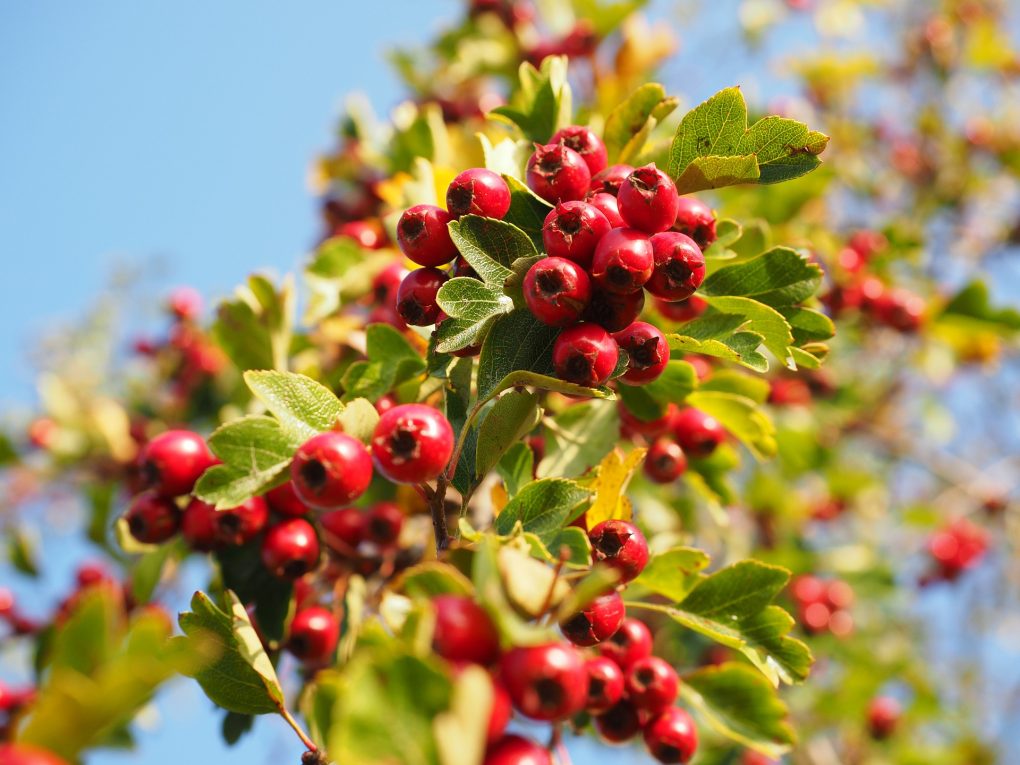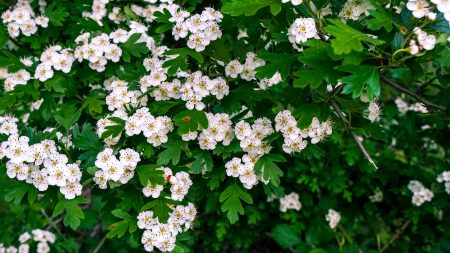
Hawthorn berries – health properties
Hawthorn, a forgotten plant, is more often associated with pharmacy than the kitchen. No wonder, as its berries, leaves and flowers have a range of health and medicinal benefits. Hawthorn is particularly valued in the prevention and treatment of cardiovascular diseases. For many years I have preserved the healing power of its berries in glass jars while preparing jam and other preserves, so that I can use them in winter 🙂
When I was little, I used to call hawthorne “mini-apples” and indeed, its fruit resemble red apples in their color and shape. The flowers, which bloom around May and June, look like blooming apple trees. These beautiful white flowers can be used when dried to prepare perfect teas for autumn and winter when we need those extra valuable nutrients to protect us from infections.
In autumn, when these red fruit are ripe on the bushes in parks, gardens and fields, I begin my culinary experiments. Sometimes I head to street markets to buy them dried and other times I use them fresh. I usually prepare them in several ways. I especially love jams and preserves, but hawthorn can also be used for making liqueurs, wines and teas.
Hawthorn berries contain flavonoids and are rich in vitamin C and beta-carotene, B vitamins, pectin, minerals and organic acids.
Treatment of cardiovascular diseases
Hawthorn is traditionally used for prevention and help in the treatment of cardiovascular diseases. It is not by accident that I have mentioned this feature first. These diseases are the most common cause of deaths in Poland. Scientific research showhs that this plant should be used in the kitchen also for other reasons.
Lowering cholesterol
Hawthorn extracts show hypolipemic effects, they affect the reduction of total cholesterol, LDL cholesterol (“bad” cholesterol) and triglycerides and at the same time increase HDL cholesterol (commonly known as “good” cholesterol). And these benefits could already suffice as high cholesterol seems to be one of the dominant health problems in adults.
Reduction of atherosclerotic deposits
Hawthorn extract contains proanthocyanidins, which play an important role in the prevention of atherosclerosis. The same compound is found in grapes, which are famous for their beneficial effects on atherosclerosis. I have already written about the cholesterol lowering properties, but what’s more, hawthorn also reduces the size of existing atherosclerotic deposits.
Lowering blood pressure
The active compounds contained in hawthorn reduce the resistance of blood vessels (eg they increase the inflow of blood to the heart by expanding blood vessels), which as a result reduces blood pressure. I found clinical trials in which a drop in systolic and diastolic blood pressure, lowering of the heart rate as well as a reduction in the incidence of arrhythmia were observed. These are the properties of hawthorn appreciated for centuries by folk medicine! Hawthorn preparations administered under medical supervision are very effective in the early stages of heart failure and arrhythmia, especially for the elderly. This has been proven many times in research. Health properties of hawthorn surprise me whenever I reach for scientific reports about it.
Antimicrobial support
Turker et al. presented the results of studies that show that hawthorn extract was characterized by strong antimicrobial activity against a number of pathogenic bacteria and showed antifungal properties. For this reason, hawthorn tea is recommended in winter. Thanks to the flavonoids it contains, hawthorn has anti-inflammatory effects. These compounds prevent the synthesis and release of inflammatory agents, including histamine. It has been demonstrated in many in vitro and in vivo studies that hawthorn preparations strengthen the immune system.
Our ancestors used to appreciate the properties of hawthorne, and so do I by using it in my preserves. In order to fully enjoy the beneficial effects of hawthorn tea and other preparations on circulatory system, heart or immunity, it must be used on a regular basis. Remember that hawthorne can be used as prevention or as a supplement to professional treatment carried out under the supervision of a doctor. Hawthorn may show drug interactions, so be careful if you take some medicines regularly. People with too low pressure should also be careful about it.
Bibliography:
- Edwards J.E, Brown P.N., Talent N., Dickinson T, Shipley P: A review of the chemistry of the genus Crataegus. Phytochemistry 2012, 79, s.5-26.
- Kulczyński B, Gramza-Michałowska A.: Potencjał prozdrowotny owoców i kwiatów głogu. Problemy Higieny i Epidemiologii 2016, 97, s. 24-28
- Król D: Głóg (Crataegus monogyna (L.), Crataegus oxyacantha (L.)) – cenną rośliną leczniczą. Postępy Fitoterapii2011, 2, s. 122-126.
- Turker AU, Yildirim AB, Karakas PT: Antibacterial and antitumor activities of some wild fruits grown in Turkey. Biotechnol Biotechnol Equip 2012, 26(1), s. 2765-2772.
- Wykurz P, Muszyńska B.: Phytotherapy as an alternative method to support treatment of hypertension. Medicina Internacia Revuo 2017, 3, s.108.










Comments No Comments
Join the discussion…